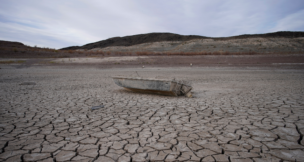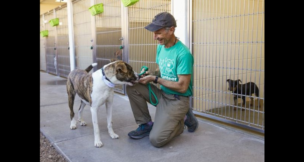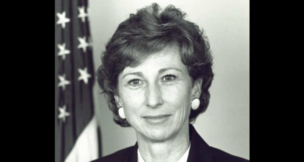Arizona Homeland Security Office Prepares To Meet Terror Threat Challenge
Arizona Capitol Reports Staff//March 26, 2004//[read_meter]
Arizona Homeland Security Office Prepares To Meet Terror Threat Challenge
Arizona Capitol Reports Staff//March 26, 2004//[read_meter]
Frank F. Navarrete, director of the Arizona Office of Homeland Security, is worried about public complacency.
Though the tragedy of Sept. 11, 2001, and its aftermath remain a topic of national discussion, with a presidential election in the offing and the country heading into a second year of war in Iraq, Mr. Navarrete fears that the overall urgency of the domestic terror threat may be waning.
He’s committed to maintaining that sense of urgency across the state. Not, he says, “to alarm,” but “to push the process of alertness and concern” so that it’s a part of our lives.
In preparing for the threat of a terrorist attack within the state, Mr. Navarrete’s office is securing the resources that he says will be necessary both to prepare for a catastrophe and to respond to one.
Mr. Navarrete says he’s concerned that some procedures may be beyond the scope of the budget provided by the state. “My biggest shortfall today is additional qualified resources to do the things that we know we should be doing,” he says. “In the future, as our programs evolve, we’ll need to put dollar figures with them, and our issue will be funding them.”
The Arizona Office of Homeland Security has no shortage of plans designed to respond to terrorism. The office, created by Governor Napolitano, is charged with ensuring that Arizona remains safe from terrorism and establishing procedures with federal, state and local agencies in the event of terrorist activity or other emergencies.
As part of his duties, Mr. Navarrete manages the state’s homeland security plan, a document that outlines a number of actions to be taken to shore up security within the state, as well as communications among Arizona’s many safety agencies.
A Staff Of Six
That’s no small task considering the security agency’s size, a staff of six.
The staff includes Southwest border and finance specialists, a projects expert dealing with continuity, such as where to locate the governor in the event of an attack, a deputy director and an administrative assistant.
Mr. Navarrete is the key player in this equation. He comes from a background in law enforcement. He spent 18 years with the Phoenix Police Department and now not only directs the Arizona Office of Homeland Security, but also the Arizona Division of Emergency Management, the lead state agency providing direction and control of emergency operations during natural and technological disasters.
He also serves as chair of the State Emergency Response Commission, which has oversight responsibility for private corporations that manufacture, transport and store hazardous materials.
Still, the Homeland Security department’s small size belies the importance of its mission, says the director. However, there are creative methods of dealing with that problem, Mr. Navarrete says.
“It’s a staffing in progress. It’s not that we’re growing, but it’s a new division and, quite frankly, there’s more than enough to do. We’re approaching the short-staffed issue in this way: we’ve asked other directors about loaning experts in various subject matters, such as fire. And we’re getting a good response to this.”
Mr. Navarrette reports seeing a good response to several department initiatives, including establishing radio procedures shared among agencies — a vital component in responding to an emergency. The Homeland Security office also is developing the first statewide mutual-aid agreement to ensure that support can be smoothly and swiftly distributed among offices dealing with terrorism. “It’s a work in progress,” says the director.
Also in progress are a number of “action items,” outlined by the state in the 2003 plan, “Securing Arizona: A Roadmap for Arizona Homeland Security.” Some address communication among agencies; others are aimed at expanding and sharpening the gathering of information.
The department, for example, has been assigned the task of establishing a statewide radio system linking independent wireless voice and data systems used by federal, state, local, tribal and private sector first and second emergency responders.
According to Mr. Navarrete, the technology required in such a system isn’t available — yet. So the question, he says, is what steps can be taken immediately with available technology?
“We’ve found some equipment on the market,” he says, “ and have applied it in Yuma, Santa Cruz, Pima and Cochise counties, which border Mexico, so that first responders can communicate with each other.”
A host of varying border agencies has joined in establishing this radio system, including fire departments, the U.S. Border Patrol and the Mexican counterparts of American first responders. By year’s end, the director says, this system, or something similar, should be available to agencies across the state. “It’s a good challenge, and a good objective.”
2-1-1 System
Another plan requires the department to establish a statewide 2-1-1 telephone system. One of the system’s functions would be to serve as a disaster information network to connect citizens to relief services during state emergencies. The Federal Communications Commission in July 2000 assigned the three-digit access codes to be used for community information and referral, including emergency alerts, job programs and domestic violence shelters and food banks. Forty states are considering developing such a system, according to the Governor’s Council on 2-1-1.
Ms. Napolitano issued an executive order Feb. 19 establishing a 2-1-1 council to plan and create a statewide phone network, which would include a Web site, database and call centers.
However, Mr. Navarrette believes the system can be used by his office.
“This is a social services program,” says Mr. Navarrete. “However, the average person may not realize that there’s an intelligence benefit to this. To monitor this network and system, and fold it into our intelligence center would provide us with interesting data.”
The Homeland Security office, for example, could monitor and detect an increased number of calls for services in a particular area — say, with regard to the disposal of dead animals within a certain part of the state. “We’d be able to look into it and see what was causing it.”
Similarly, the department is also charged with establishing a statewide disease surveillance system that collects information from emergency rooms, physicians, animal control entities, pharmacies and other public safety concerns, in order to identify emerging public health problems. Examples include naturally occurring diseases, environmental issues and biological and chemical weapons attacks.
This project is under way and overseen by the U.S. Department of Health Services.
The Border
The Homeland Security office also intends to bolster the relationship between the state and the U.S. Border Patrol. To accomplish this, Mr. Navarrete has assigned a Southwest border specialist to work on “balancing security issues with the border, while still maintaining the commercial viability of border activities.”
“This is a big challenge,” he says, “with both sides heavily dependent on each other … This could almost be a full-time job in and of itself.” Arizona Homeland Security officials work closely with their Mexican commerce and security counterparts, Mr. Navarrete says. “This is a highly visible issue today, and will continue to be so. So we try to stay aware at all levels.”
The Security office also calls for the agency to develop a homeland security funding strategy. Mr. Navarrete calls this program ongoing
. The state receives federal funding for defense against weapons of mass destruction — providing for response training, for instance — but funding for long-term needs is more tenuous. “We will continue to assess needs and gaps,” he says, “and will put together a statewide funding strategy above and beyond the current funding from the federal level.”
All in all, he says, the state department is fueled by solid ideals and the desire to push safety strategies. Compared to neighboring states, “We’re in decent shape, and we’re definitely not behind the curve.”
“Given the number of resources we have here, and the magnitude of the challenge,” says Mr. Navarrete, “I’ll say that we’ve done very well meeting those challenges.” —

















